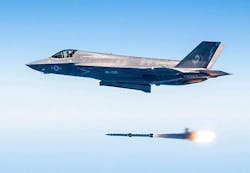Navy seeks simulations of rapidly changing airborne threats to help enhance F-35 strike fighter targeting
Officials of the Naval Air Systems Command at Patuxent River Naval Air Station, Md., issued a source-sought notice (N00019-18-R-0028) on Monday for the F-35 Radio Frequency Environment project. This initiative seeks to expand the library of simulated coherent radar and EW signals for inclusion in the F-35 JSF Reprogramming Enterprise (JRE) laboratories.
The F-35's advanced sensor suite is more sensitive than that of any other combat aircraft before it, and military avionics experts are still working on identifying everything the F-35 sensors can detect.
To identify enemy missile launches, radio frequencies, weapons, sensors and other adversary systems correctly, the F-35's avionics must be able to match detected signals against known signatures of enemy systems stored the plane's software called threat libraries.
Without the ability to match detected signals against known threats, the F-35's sensitive sensor suite might not be sure of what it's seeing. Navy experts want the ability to simulate rapidly changing threats that F-35 sensors detect to refine and update the plane's on-board threat libraries.
Related: Simulation & training: expecting the unexpected
Navy experts want these simulations to include hardware and software that are compatible with the radar and EW subsystems aboard the F-35. Experts want to test new simulation equipment against f-35 equipment available the original manufacturers, because government-provided equipment is not available for this effort.
In addition, Navy experts are looking for digital models of susceptibility, as well as high-fidelity F-35 radar models. Navy experts say they expect to order this equipment from August 2018 through 2022.
Companies interested that have the necessary expertise should email written capability statements to the Navy's Kevin Harding at [email protected].
Contact Kevin Harding for questions or concerns by email at [email protected], or by phone at 703-602-5086. More information is online at https://www.fbo.gov/spg/DON/NAVAIR/N00019/N00019-18-R-0028/listing.html.
Ready to make a purchase? Search the Military & Aerospace Electronics Buyer's Guide for companies, new products, press releases, and videos
